Homemade Fruit Leather Recipe (With Money Saving Tips!)
This post may contain affiliate links. Read my full disclosure here.
We love this homemade fruit leather recipe. It’s easy to make. uses a simple tip that saves money and gives more reliable results. I’ll also share some things to avoid and which fruits work best.
You can make fruit leather (homemade fruit rolls) it in the oven or the dehydrator. Since you choose the fruit, you can avoid the artificial ingredients in some store bought fruit rolls. (Homemade is also MUCH more budget friendly than premium brands like Stretch Island fruit leather.)
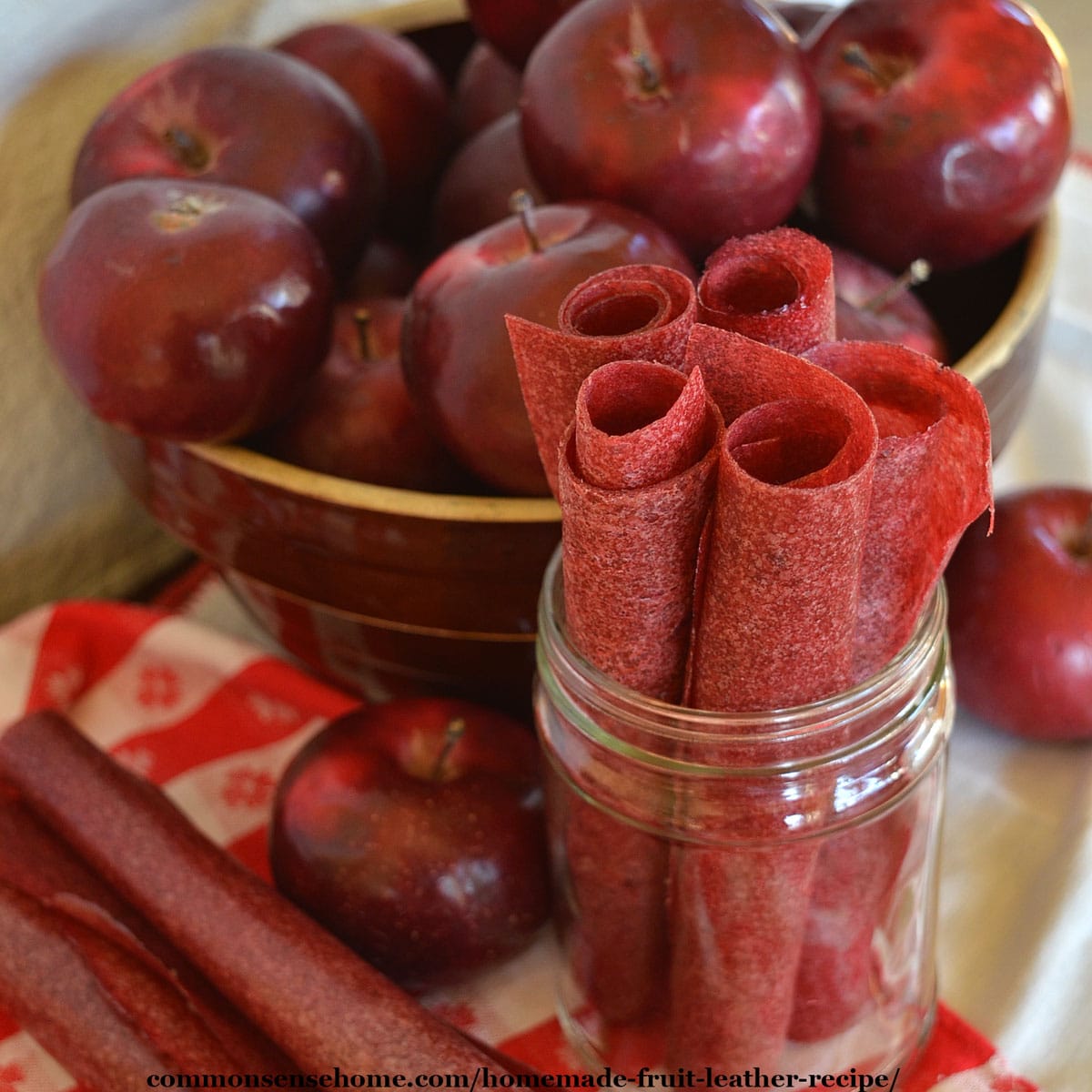
Homemade Fruit Leather Recipe for the Oven or Dehydrator
The “secret” to great fruit leather is pectin. Some fruits are naturally high in pectin, while others don’t have much. By combining applesauce with your favorite fruit, you get the signature “leather” texture instead of brittle fruit jerky.
Adding applesauce also mellows out the flavors and adds sweetness to tart fruits. (Drying tart fruit intensifies the tartness.) Fruits like raspberries and blueberries are usually more expensive than apples, so adding applesauce saves money. The finished fruit leather still tastes like berries.
You can also save money by using fruit that would otherwise go to waste. I hate it when I stock up on something, only to have the family stop eating it. This is a great way to turn those overripe pears or bananas into a whole new snack. Waste not, want not.
To make an 11×17 baking sheet of fruit leather or two Excalibur dehydrator trays, combine:
- 2 cups applesauce
- 2 cups fresh fruit puree (about one pound of fruit)
Homemade applesauce works best. If you don’t have any applesauce on hand, just core and chop a pound of apples and puree them.
Add the fruit mixture (applesauce and favorite fruit) to a medium stock pot. Simmer the fruit over low heat to thicken, stirring occasionally. If you’d like to add sweetener or spices (like pumpkin pie spice), this is the time to do it.
Cooking the fruit activates the gelling characteristics of the pectin. Acid helps to activate the pectin, too, so adding lemon juice is helpful for low acid fruits.
Once the puree thickens, remove from heat and cool completely. Now you’re ready for drying the fruit leather recipe.
Oven Drying
Line your baking sheet with parchment paper or a silicone mat. Spread the cooked puree into a thin, even layer.
Place the fruit filled baking sheet in a low temperature oven. Around 140°F (60°C) is great if you can set the oven that low. If your oven is hotter, you’ll need to reduce drying time.
Bake at 140°F (60°C) until barely tacky, about 8-9 hours.
Dehydrator Drying
To make it easier to get your finished fruit leather off, oil the fruit roll sheets lightly. Use an oil without a strong flavor, such as refined coconut oil. Spread the room temperature puree evenly over the sheet in a 1/4 inch thick layer.

Load trays into dehydrator and dry at 135°F (57°C) for 8-20 hours. When dry, fruit leather should feel “leathery” – not sticky.
Drying times will vary depending on the:
- dehydrator model
- liquid in fruit
- humidity levels in the air
- thickness of the fruit puree on the fruit leather tray
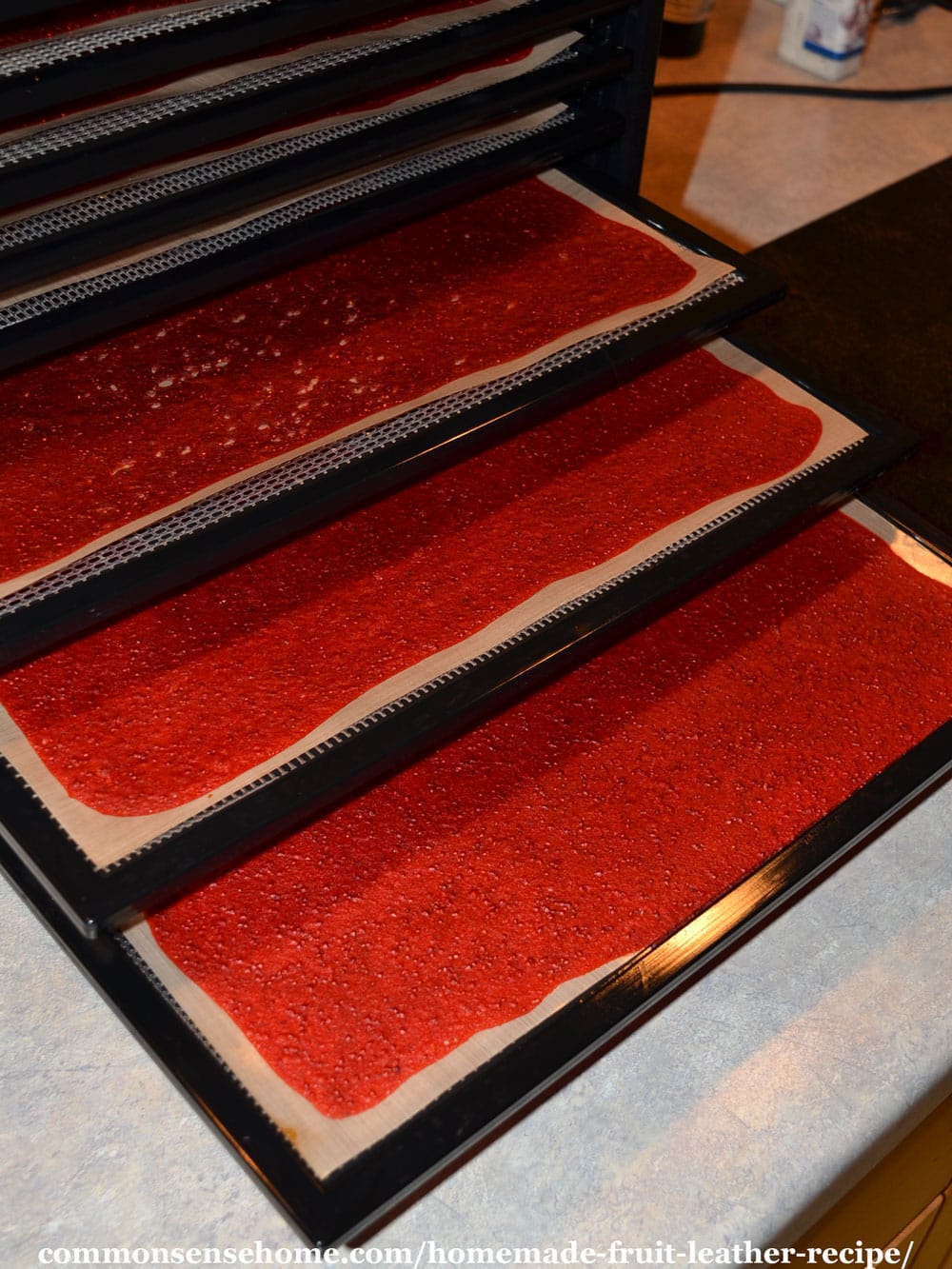
Sometimes you may notice that the underside is sticky when you peel up thicker leather. If this is the case, flip the moist side up and load it back into the dehydrator until evenly dry. (You can typically remove the fruit leather sheet at this time for better air circulation.)
To Store Your Homemade Fruit Leather
Once dry, cut your fruit leather recipes into small sheets or strips. To keep the fruit leather sheets from sticking together, dust them with arrowroot powder or cornstarch. If you made your fruit leather on disposable parchment paper, you can keep the paper on for storage.
Store the finished leather in an airtight container. We keep ours in a wide mouth mason jar, or zip top plastic bag.
If properly dried, this homemade fruit leather should be shelf stable. We’ve kept some in the pantry for over a year. If you’re not sure about the dryness, store it in the refrigerator or freezer.
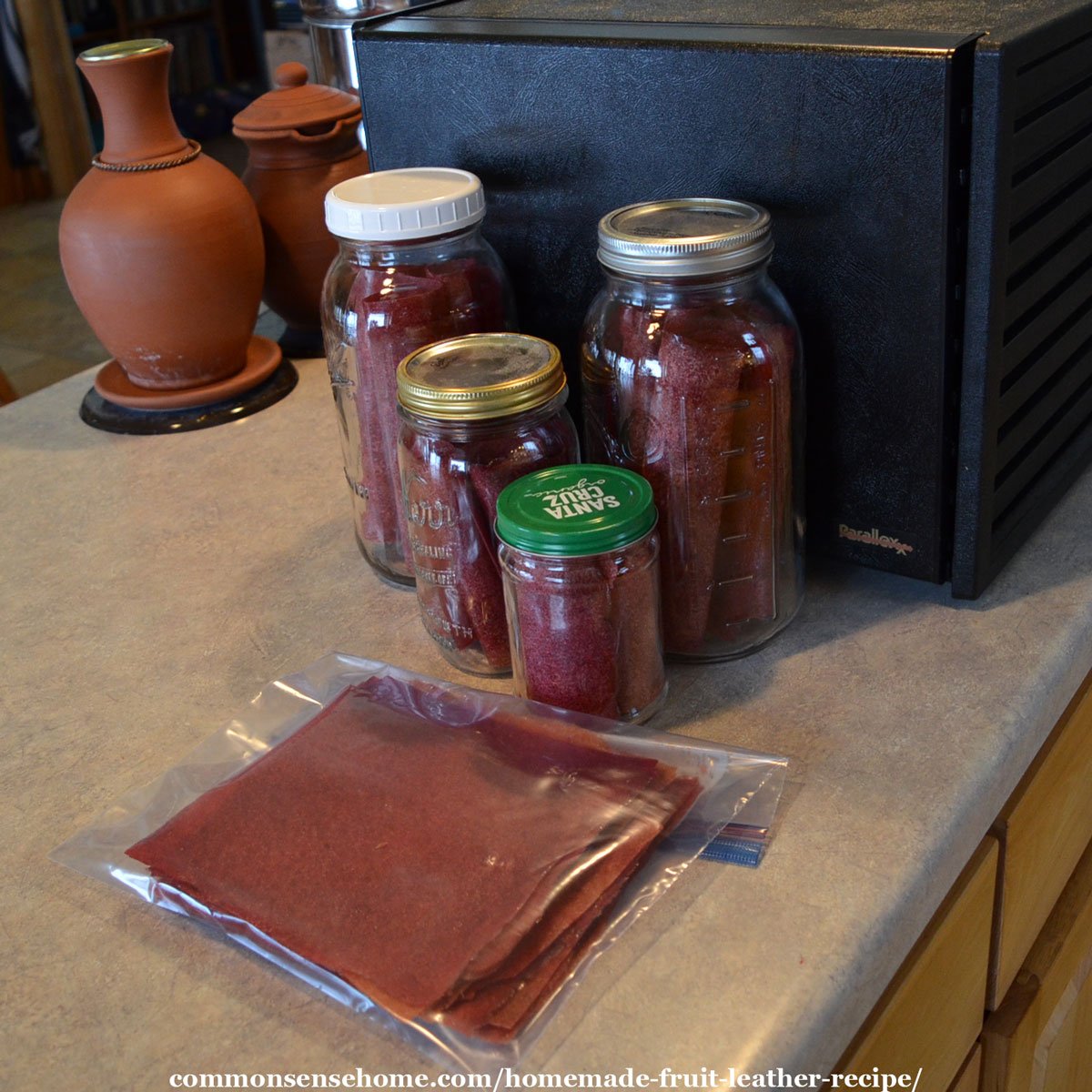
Sweetener
We usually don’t add sweetener, but if your fruit is less ripe, you may want some.
Try a spoonful of honey or maple syrup, or 1-3 tablespoon of fruit juice concentrate. Orange juice concentrate adds a little citrus brightness, but any fruit juice concentrate will do. You can also use sugar substitutes, such as powdered Swerve.
Would you like to save this?
Mistakes to Avoid
Do not use plastic wrap, wax paper, or aluminum foil for your fruit leather recipe. Plastic wrap and wax paper can melt in the oven, and all three will stick to the fruit roll.
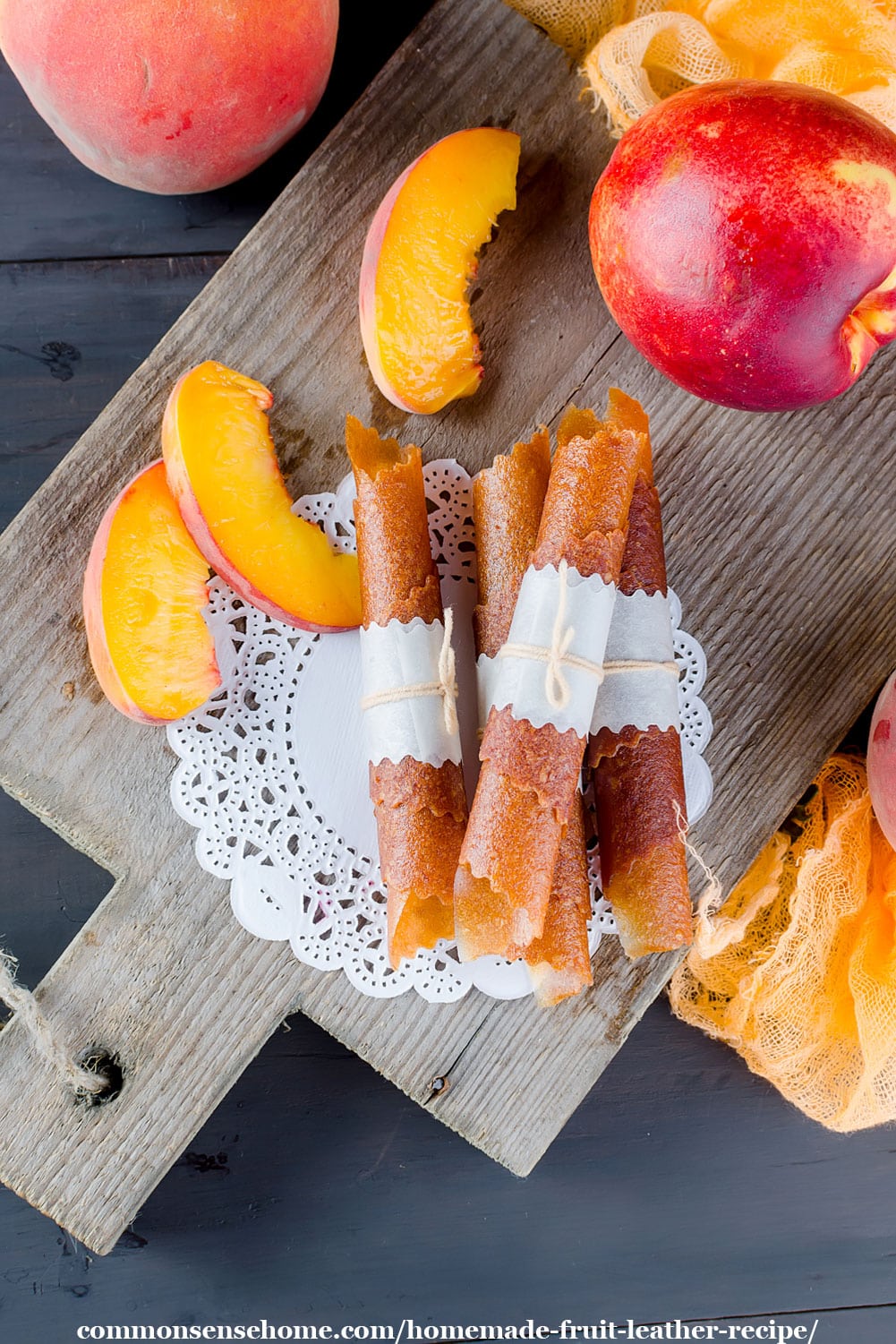
Which Fruits are Best for Homemade Fruit Leather?
You can make this homemade fruit leather recipe with a variety of fruits. It’s fine to use fresh, canned or frozen fruit (thawed). Citrus and melons do not work well in homemade fruit leather.
Drain canned or thawed fruit before use to reduce drying time. Canned fruits contain extra liquid (and often sugar), which increases drying times.
You can make fruit leather with any high pectin fruits by themselves. Low pectin fruits work much better with added pectin. For instance, peach leather or mango leather works well, but plain raspberry leather is brittle.
Fruits that are naturally high in pectin include:
- apples
- apricots
- bananas
- blackberries
- blueberries
- cranberries
- currants
- figs
- gooseberries
- grapes
- guavas
- mangoes
- peaches
- pears
- pineapples
- plums
Fruits that have less pectin include:
- cherries
- citrus fruits
- melons
- pomegranates
- raspberries
- strawberries
- rhubarb
(Lists adapted from Mary Bell’s Complete Dehydrator Cookbook.)
Handy tip – save time by keeping the tops on your strawberries. Strawberry tops contain vitamin C, iron, calcium, and some pectin.
Bananas have a pH around 5, so it’s safest to pair them with other fruit and lemon juice. (Remember, we want a pH below 4.6 to prevent microbe growth.)
If you don’t want to use applesauce, you can also purchase powdered apple pectin for thickening. Add 1-2 tablespoons per 3 cups puree.
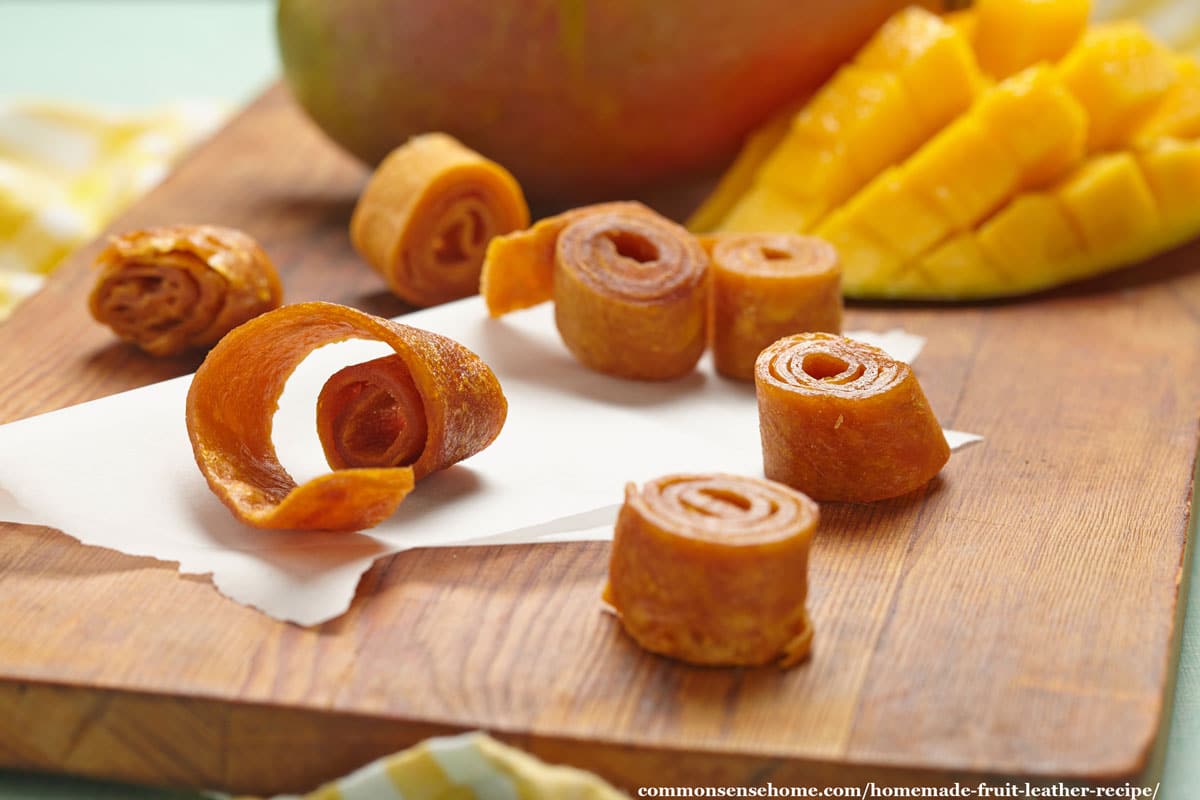
Recommended Equipment for Making Homemade Fruit Leather
It’s pretty easy to whip up a batch of fruit leather, but a few kitchen tools are needed.
Blender – Think applesauce consistency for your puree. I currently have a Vitamix, but any reasonably high powered blender or food processor will do.
Dehydrator or oven – You can make homemade fruit leathers in a basic unit like a Snackmaster, or even a homemade dehydrator. Sun Ovens an also be used for dehydrating.
I like the Excalibur dehydrator for making fruit leather. The square shape makes it easy to spread the fruit mixture and cut the fruit roll strips.
Fruit Leather Sheets – I bought these basic non-stick sheets for my Excalibur. Their ParaFlexx fruit leather sheets are sturdier, but more expensive. If you do a lot of leathers or foods with smaller pieces, they may be worth the investment.
Snackmaster dehydrators come with two fruit roll sheets, but you can also purchase additional fruit roll sheets.
Print Friendly Recipe
PrintHomemade Fruit Leather Recipe
This budget friendly fruit leather recipe is a great way to turn extra fruit into a fun snack that will be ready in the pantry when you need it.
- Prep Time: 5 minutes
- Drying Time: 460 minutes
- Cook Time: 10 minutes
- Total Time: 7 hours 55 minutes
- Yield: 10 servings 1x
- Category: Snack
Ingredients
- 2 cups applesauce (about one pound of apples)
- 2 cups fresh fruit puree (about one pound of fruit)
- sweetener and lemon juice (optional)
Instructions
- Clean and chop your fruit and puree it in a food processor or blender. Pour the fruit mixture into a medium stockpot.
- Add a spoonful of honey or maple syrup, or 1-3 tablespoon of fruit juice concentrate, if desired, for extra sweetness. Add a tablespoon of lemon juice (or more) for extra tartness.
- Simmer the fruit over low heat to thicken, stirring occasionally. Once the puree thickens, remove from heat and cool completely.
For oven drying:
Line an 11×17 baking sheet with parchment paper or a silicone mat. Spread the cooked puree into a thin, even layer.
Place the fruit filled baking sheet in a low temperature oven. Around 140°F (60°C) is great if you can set the oven that low. If your oven is hotter, you’ll need to reduce drying time.
Bake at 140°F (60°C) until barely tacky, about 8-9 hours.
For dehydrator drying:
To make it easier to get your finished fruit leather off, oil the fruit roll sheets lightly. Use an oil without a strong flavor, such as refined coconut oil or cooking spray. Spread the room temperature puree evenly over the sheet in a 1/4 inch thick layer.
Load trays into dehydrator and dry at 135°F (57°C) for 8-20 hours. When dry, fruit leather should feel “leathery” – not sticky.
Notes
Storage:
Once dry, cut your fruit leather recipes into small sheets or strips. To keep the fruit leather sheets from sticking together, dust them with arrowroot powder or cornstarch. If you made your fruit leather on disposable parchment paper, you can keep the paper on for storage.
Store the finished leather in an airtight container. We keep ours in a wide mouth mason jar, or zip top plastic bag.
If properly dried, this homemade fruit leather should be shelf stable. We’ve kept some in the pantry for over a year. If you’re not sure about the dryness, store it in the refrigerator or freezer.
*Nutrition data based on an all apple fruit leather.
Have you made homemade fruit leather? If so, what’s your favorite flavor combination? Leave a comment and let me know!

More Common Sense Home Preserving Guides:
- 12 Ways to Preserve Strawberries – Plus Tips to Keep Berries Fresh Longer
- Preserve Apples for Year Round Use 17 Easy and Creative Ways
- 5 Ways to Preserve Peaches
- Pumpkin Fruit Leather – tastes like portable pumpkin pie
- Plum Preserves
Originally published in 2016, last updated in 2023.

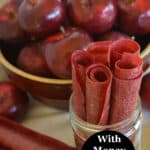
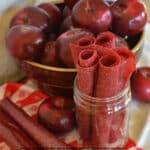
Do you have to cook the apples into sauce? Or can I simply puree raw apples and use that? If I don’t need apple sauce, I’d rather skip the step. Thank You!
It’s safe to do, but the texture will not be the same. Cooking breaks down the fiber, resulting in a smoother, more pliable leather. It also helps release natural pectin, which improves texture. With cooking, you get the characteristic fruit leather texture. Without cooking, the end product will be more more prone to crumbling. End results will vary based on the apple variety used.
Is there any problem with using regular disposable parchment paper to make my fruit leathers?paper
Yes. You can do it, but even if you oil the parchment paper, the fruit likes to stick and it’s a bear to peel the parchment off. Freezer paper might work better because it’s a little thicker, but if you think you want to make fruit leather a few times, getting the fruit leather inserts/sheets is worth it.
a few questions for you, you may not be able to answer them in which case please let me know.
looking at something like this for me to consume raw fruit and veg as I have oral allergy syndrome….an allergy to anything that comes from a pollen….ie fruit veg tree nuts and honey.
I can eat most fruit and veg if it is cooked with a few exceptions as cooking breaks down the proteins hat causes the allergies. Does dehydrating break down the proteins in the fruit and veg do you know?
If so apples is one fruit I cannot eat so would any other fruit replace the apple in fruit leathers?
would be grateful for answers if you have the time elaine.livingstone@***.com
thanks
From what I was able to find online and talking to friends dealing with OAS, the answer is “maybe”. Dehydrating alone may not be enough, but if you cook, then dehydrate, your odds are better. If you need to avoid apples entirely, try some of the other high pectin fruits.
One friend’s daughter was also able to tolerate freeze dried fruits, but not fresh. We have more information on home freeze drying here.
Different cultivars may have more or less allergenic potential, as noted in the study “Allergy potential of strawberries and tomatoes depends on the variety“. Unfortunately, the study doesn’t list which varieties tested safer.
Is there any way to make this in an oven? I don’t have a dehydrator but would still love to make some.
The home food drying post (https://commonsensehome.com/home-food-drying/) has options for oven drying, air drying and solar drying, as well as links to DIY dehydrator instructions.
This is an awesome page! I’ve just bought a commercial dehydrator. I’m looking to make these fruit leathers. I have a few questions.
1) If using all fresh fruit and apple sauce ( from a can that is good for 1 year). What expiry date should I write on the bags?
2) Will this work with veggies as well?
Thanks in advance!
I try to use dehydrated items within one year for best quality.
I suppose you could use veggies, but I’d probably stick to sweeter ones like carrots or beets or a blend. I don’t think Swiss chard leather would make you very popular with most snackers, but I may be mistaken.
I’m new to dehydrating and having pretty good luck… except pineapple. The one flavor my daughter requests and it never turns out. It always turns into a cracker. I’ve adjusted the heat, I’ve added a banana to thicken. I am thinking I should try reducing on the stove? After reading your blog I wonder if apple would help. The lady in Welicious does it rare with no problems. Im at a loss… any suggestions?
I haven’t tried pineapple fruit leather, but one recipe I found suggests:
3 cups chopped pineapple, about 1 medium pineapple
2-3 tablespoons honey
1 tablespoon orange juice
1 teaspoon orange zest
All ingredients are blended raw and then spread on sheets and dried.
Which brand of dehydrator has their service (repair)centre at Asansol (westbengal).
Does Excalibur have this?
How much (in kg)vegetable do I dehydrate in a day in a Excalibur 5 tray dehydrator? Or any similar dehydrator available at Asansol.?please reply through email as early as possible.
I’m sorry, but my search engine results for West Bengal aren’t very good. There is an Excalibur dealer operating in India, so they should be available in West Bengal.
The amount of food that can be dried at one time depending on what type of food you are drying and how it is prepared for drying. The trays measure 38 cm x 8 cm.
After making, can the leather be canned? If so, would just a hot water bath be enough?
If properly dried, the fruit leather should be shelf stable. Drying inhibits bacteria growth, as does the acidity of the fruit. I still have a little bit leftover from last year in the pantry in a mason jar, and it’s just fine. No fur, no off flavor.
Canning doesn’t work well with dry foods, because it relies on conductive heat transfer from water or steam to the liquid contents in jars. The liquid allows the heat to evenly distribute throughout the jar.
Is it necessary to cook the Fruit? I cannot get the fruit leather to dry out in the middle and if i try it makes the edges beyond dry. Help! I was cooking the strawberries for 20 min with a little honey and then blending them. What am i doing wrong?!?!
I don’t cook the strawberries. The applesauce is cooked. Using honey will increase drying time versus a similar amount of sugar, as it tends to hold water even more than sugar.
You may want to consider spreading the fruit in strips, rather than filling the trays, or trying to make sure that you’re spreading it thicker by the edges and thinner in the center. Another option would be to peel the leather off the tray half way through when it is set up enough to handle but not completely dry. Flip it over and finish drying on a mesh screen instead of on the fruit roll trays. You can also cut or peel off outer edges that are dry, and leave thicker areas in the dehydrator to finish drying.
Based on your recommendation, I purchased the Excalibur dehydrator which came by UPS yesterday. However, I forgot to order the sheets for making fruit leather. We don’t always get decent fruit from our trees in Northern Nevada (Reno area) due to late spring frosts. But this year? wow! My apricots are the size of large peaches. I’ve bottled all I could (wide mouth quart canning jars are nonexistent in this area, too. I wisely purchased 6 cases early on but now they’re all gone everywhere) so now I’m on to making fruit leather, which I haven’t done in ages. I keep reading in the instruction book that I can use “plastic wrap” or their ParaFlexx sheets, which I forgot to order! Are they talking about plain “saran wrap” type of plastic wrap or can I use wax paper? Also, being as apricots have high pectin, can I just clean them up and pit them, and puree them in the blender, skin and all and use that for the fruit leather? Do I need to/should add anything else? Thanks for your help!!
I have tried both plastic wrap and wax paper, and it can be tough to remove the finished fruit leather from them. It’ll work in a pinch, but the sheets are so much easier to work with. I didn’t invest in the ParaFlexx sheets yet. Instead I opted for the reusable parchment basic non-stick sheets. They aren’t quite as nice as the ParaFlexx sheets, but they get the job done and are much less expensive. They are light, so they ship fast, too.
Apricot can be used to make a leather on their own, but it may be a little acidic for some palates, depending on the fruit. If the flavor is too strong, cut with applesauce to taste.
Thank you for the information; I ordered the reusable sheets from Amazon. I have no idea how much I’ll use this dehydrator but it’s sure going to come in handy with this year’s bumper crop of fruit.
I’m going to cut applesauce in with the apricots; I’ll just need to figure out the ratio.
Thanks again for all your help. I love reading your site and getting all the helpful information.
You’re welcome. I find my dehydrator use goes in cycles. When it’s harvest season, I use it almost daily. In the middle of winter, less often. That’s mostly jerky and yogurt season – or even proofing bread if the house is chilly.
I was wondering this very thing, since my Presto Dehydro doesn’t come with fruit leather sheets. Sounds like it’s worth the extra money though! Thanks!
The sheets are great for other small items, too, like tiny herb leaves.
My granddaughter is allergic to sorbitol found in apples and pears. Can I use apricot, peaches or other fruit high in pectin as the base. She obviously couldn’t have the apple based pectin sugar.
You should be able to get an acceptable product, but it will likely take some experimenting to find the flavors and texture you like. Applesauce is typically used because it makes a neutral flavor base and smooth texture. I’d start with small batches and keep notes on what works and what doesn’t.
Thank you for this! I really want to try it.
You’re welcome!